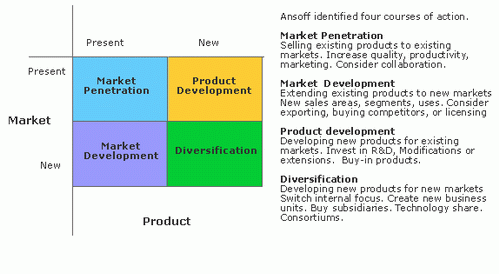Ansoff Matrix
The Ansoff product/ market matrix is a tool that helps businesses decides their product and market growth strategy.
It suggests that a business' attempts to grow depend on whether it markets new or existing products in new or existing markets.
It is used by marketers who have objectives for growth. Ansoff's matrix offers strategic choices to achieve the objectives. There are four main categories for selection.

The four main categories
Market Penetration (existing markets, existing products)
Here we market our existing products to our existing customers.
- This means increasing our revenue by, for example, promoting the product, repositioning the brand, and so on. However, the product is not altered and we do not seek any new customers.
- Market penetration seeks to achieve four main objectives:
- Maintain or increase the market share of current products - this can be achieved by a combination of competitive pricing strategies, advertising, sales promotion and perhaps more resources dedicated to personal selling.
- Secure dominance of growth markets.
- Restructure a mature market by driving out competitors; this would require a much more aggressive promotional campaign, supported by a pricing strategy designed to make the market unattractive for competitors.
- Increase usage by existing customers. For example by introducing loyalty schemes.
- A market penetration marketing strategy is very much about "business as usual". The business is focusing on markets and products it knows well. It is likely to have good information on competitors and on customer needs. It is unlikely, therefore, that this strategy will require much investment in new market research.
Market Development (new markets, existing products)
Here we market our existing product range in a new market.
This means that the product remains the same, but it is marketed to a new audience. Exporting the product, or marketing it in a new region, are examples of market development.
Market development is the name given to a growth strategy where the business seeks to sell its existing products into new markets.
There are many possible ways of approaching this strategy, including:
- New geographical markets; for example exporting the product to a new country
- New product dimensions or packaging: for example New distribution channels
- Different pricing policies to attract different customers or create new market segments
Product Development (existing markets, new products):
This is a new product to be marketed to our existing customers.Here we develop and innovate new product offerings to replace existing ones. Such products are then marketed to our existing customers. This often happens with the auto markets where existing models are updated or replaced and then marketed to existing customers.
Business Diversification (new markets, new products):
This is where we market completely new products to new customers.The diversification can be divided again into horizontal, vertical and lateral diversification.
Diversification is an inherently higher risk strategy because the business is moving into markets in which it has little or no experience.
For a business to adopt a diversification strategy, it must have a clear idea about what it expects to gain from the strategy and a transparent and honest assessment of the risks.





